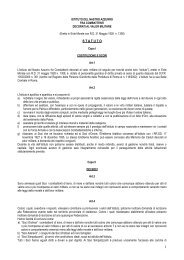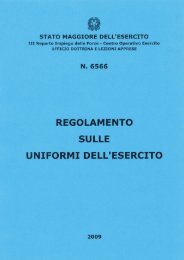Contours of Conflict in the 21st Century
Contours of Conflict in the 21st Century
Contours of Conflict in the 21st Century
- No tags were found...
You also want an ePaper? Increase the reach of your titles
YUMPU automatically turns print PDFs into web optimized ePapers that Google loves.
THE METAFORE PROTOCOL• Parameters are def<strong>in</strong>ed as <strong>the</strong> key attributes <strong>of</strong> <strong>the</strong> future nature <strong>of</strong>conflict that are likely to change <strong>in</strong> <strong>the</strong> future. The ma<strong>in</strong> question askedhere is: what is it about conflict that is likely to change <strong>in</strong> <strong>the</strong> future.• Drivers are def<strong>in</strong>ed as <strong>the</strong> forces that are likely to trigger changes <strong>in</strong> <strong>the</strong>parameters. The ma<strong>in</strong> question asked here is: what is likely to drivechange <strong>in</strong> <strong>the</strong> nature <strong>of</strong> future conflict.Aga<strong>in</strong>, as for <strong>the</strong> search queries, we made a conscious choice not to preimposeany taxonomy on <strong>the</strong> coders but ra<strong>the</strong>r to develop that taxonomy<strong>in</strong> a few ‘spirals’. 8 On <strong>the</strong> basis <strong>of</strong> a close read<strong>in</strong>g <strong>of</strong> a subset <strong>of</strong> texts, aprelim<strong>in</strong>ary list <strong>of</strong> parameters and drivers was developed <strong>in</strong>ductively by<strong>the</strong> Ch<strong>in</strong>ese, Russian and English Metafore teams. The <strong>in</strong>itial list wascomplemented and ref<strong>in</strong>ed on <strong>the</strong> basis <strong>of</strong> a number <strong>of</strong> <strong>in</strong>-house HCSSexpert sessions. The list that was thus obta<strong>in</strong>ed was consequently tried outon a small number <strong>of</strong> texts to determ<strong>in</strong>e whe<strong>the</strong>r it was possible to apply<strong>the</strong> cod<strong>in</strong>g scheme <strong>in</strong> practice with some degree <strong>of</strong> consistency across <strong>the</strong>language doma<strong>in</strong>s. Once <strong>the</strong> team felt confident both about <strong>the</strong> list itselfand about its ability to code <strong>the</strong> texts consistently, <strong>the</strong> follow<strong>in</strong>g list wasagreed upon.Parameters – what is it about conflict that is likely to change <strong>in</strong><strong>the</strong> futureActors – Who are <strong>the</strong> ma<strong>in</strong> parties that may get <strong>in</strong>volved <strong>in</strong> futureconflict?• Blocs <strong>of</strong> states• Pairs <strong>of</strong> states• State and non-state actors vs. any o<strong>the</strong>r actor• State vs. non-state• Non-state vs. non-state8 We rem<strong>in</strong>d <strong>the</strong> reader that our ambition <strong>in</strong> this study is to avoid ‘presentist’ and o<strong>the</strong>r biases. Alltoo <strong>of</strong>ten <strong>in</strong> <strong>the</strong> past, our preconceived categorizations, almost <strong>in</strong>variably based on <strong>the</strong> past and<strong>the</strong> present, have been an important reason we were bl<strong>in</strong>dsided for unexpected events. NassimTaleb calls <strong>the</strong>se ‘crisp categories’ and sees it as an important reason why we miss sources <strong>of</strong>uncerta<strong>in</strong>ties. Nassim Taleb, The Black Swan: <strong>the</strong> Impact <strong>of</strong> <strong>the</strong> Highly Improbable, 1st ed. (NewYork, NY: Random House, 2007). On this po<strong>in</strong>t, also see our own work De Spiegeleire et al.,STRONG <strong>in</strong> <strong>the</strong> <strong>21st</strong> <strong>Century</strong>. Strategic Orientation and Navigation under Deep Uncerta<strong>in</strong>ty..HCSS Report 27










